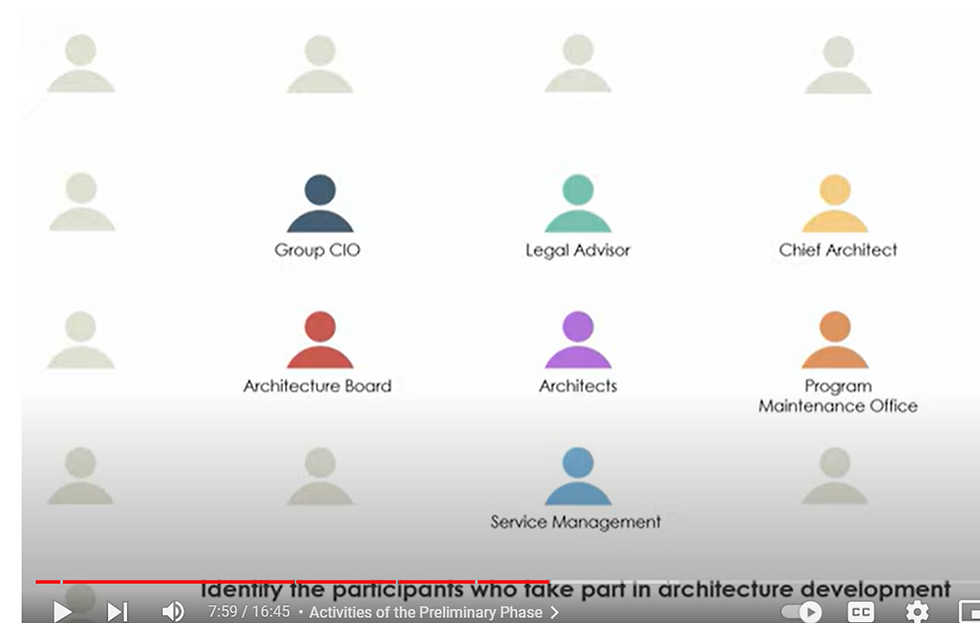TOGAF ADM
- Anand Nerurkar
- Sep 22, 2023
- 4 min read

The Preliminary Phase describes the preparation and initiation activities required to create an Architecture Capability including customization of the TOGAF framework and definition of Architecture Principles
Phase A: Architecture Vision describes the initial phase of an architecture development cycle
It includes information about defining the scope of the architecture development initiative, identifying the stakeholders, creating the Architecture Vision, and obtaining approval to proceed with the architecture development.
Phase B: Business Architecture describes the development of a Business Architecture to support the agreed Architecture Vision
Phase C: Information Systems Architectures describes the development of Information Systems Architectures to support the agreed Architecture Vision
Phase D: Technology Architecture describes the development of the Technology Architecture to support the agreed Architecture Vision
Phase E: Opportunities & Solutions conducts initial implementation planning and the identification of delivery vehicles for the architecture defined in the previous phases
Phase F: Migration Planning addresses how to move from the Baseline to the Target Architectures by finalizing a detailed Implementation and Migration Plan
Phase G: Implementation Governance provides an architectural oversight of the implementation
Phase H: Architecture Change Management establishes procedures for managing change to the new architecture
Requirements Management examines the process of managing architecture requirements throughout the ADM

Initial- preliminary - Enterprise Architecture Engagement
· Identify the business goals, drivers and objectives
· Identify the key stakeholders and their expectation, participation in architecture development
·

· Identifying the context of the architecture engagement
· Identify architecture capability required for the organization to execute enterprise architecture
· Define and scope the Enterprise
·

· Understand the architecture capability maturity assessment
·
· Define RACI with high level activities and who will be doing what
·

· Selecting architecture framework, tools,
· Selecting architecture governance framework- COBIT
· Setting up the architecture repository
· Establish Architecture Principles
o Business Principles
1. Primacy of Principles
· These principles of information management apply to all organizations within the enterprise
· The only way we can provide a consistent and measurable level of quality information to decision-makers is if all organizations abide by the principles.
2. Maximize Benefit to the Enterprise
Information management decisions are made to provide maximum benefit to the enterprise as a whole.
Decisions made from an enterprise-wide perspective have greater long-term value than decisions made from any particular organizational perspective. Maximum return on investment requires information management decisions to adhere to enterprise-wide drivers and priorities
3 Information Management is Everybody's Business
· All organizations in the enterprise participate in information management decisions needed to accomplish business objectives.
· Information users are the key stakeholders, or customers, in the application of technology to address a business need. In order to ensure information management is aligned with the business, all organizations in the enterprise must be involved in all aspects of the information environment. The business experts from across the enterprise and the technical staff responsible for developing and sustaining the information environment need to come together as a team to jointly define the goals and objectives of IT.
4 Business Continuity
· Enterprise operations are maintained in spite of system interruptions.
§ Commo n Use Applications
· Development of applications used across the enterprise is preferred over the development of similar or duplicative applications which are only provided to a particular organization.
· Duplicative capability is expensive and proliferates conflicting data.
§ Compliance with Law
· Enterprise information management processes comply with all relevant laws, policies, and regulations.
· Enterprise policy is to abide by laws, policies, and regulations.
§ IT Responsibility
· The IT organization is responsible for owning and implementing IT processes and infrastructure that enable solutions to meet user-defined requirements for functionality, service levels, cost, and delivery timing.
§ Protection of Intellectual Property
· The enterprise's Intellectual Property (IP) must be protected. This protection must be reflected in the IT architecture, implementation, and governance processes
o Data
§ Data is an Asset
· Data is an asset that has value to the enterprise and is managed accordingly.
§ Data is Shared
· Users have access to the data necessary to perform their duties; therefore, data is shared across enterprise functions and organizations.
§ Data is Accessible
· Data is accessible for users to perform their functions.
§ Data Trustee
· Each data element has a trustee accountable for data quality.
§ Common Vocabulary and Data Definitions
· Data is defined consistently throughout the enterprise, and the definitions are understandable and available to all users.
§ Data Security
· Data is protected from unauthorized use and disclosure.
o Application
§ Technology Independence
· Applications are independent of specific technology choices and therefore can operate on a variety of technology platforms.
§ Ease-of-Use
· Applications are easy to use. The underlying technology is transparent to users, so they can concentrate on tasks at hand.
o Technology
§ Requirements-Based Change
· Only in response to business needs are changes to applications and technology made
§ Responsive Change Management
· Changes to the enterprise information environment are implemented in a timely manner.
§ Control Technical Diversity
· Technological diversity is controlled to minimize the non-trivial cost of maintaining expertise in and connectivity between multiple processing environments
§ Interoperability
· Software and hardware should conform to defined standards that promote interoperability for data, applications, and technology.
· Standards help ensure consistency, thus improving the ability to manage systems and improve user satisfaction, and protect existing IT investments, thus maximizing return on investment and reducing costs.
· Standards for interoperability additionally help ensure support from multiple vendors for their products, and facilitate supply chain integration.
· Setting up organization model for enterprise architecture
o EA Team
· Develop request for architecture work
· Budget Requirement
.png)

Comments